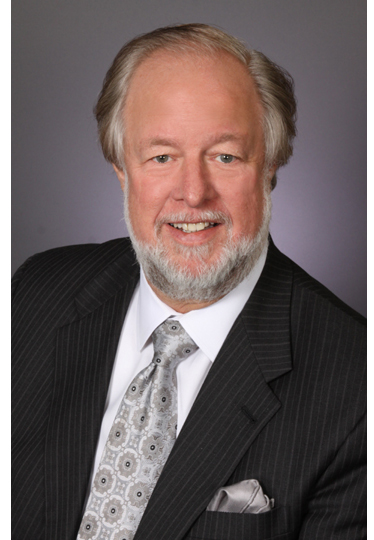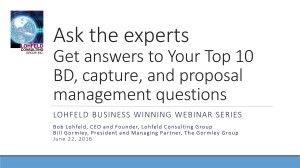Q&A Part 1: Breaking into government markets
Watch the webinar replay and listen to the podcast (MP3)
 Recently, Bob Lohfeld, CEO, Lohfeld Consulting Group and Bill Gormley, President and Managing Partner, The Gormley Group discussed various challenges faced by BD, capture, and proposal professionals supporting Federal Government contractors.
Recently, Bob Lohfeld, CEO, Lohfeld Consulting Group and Bill Gormley, President and Managing Partner, The Gormley Group discussed various challenges faced by BD, capture, and proposal professionals supporting Federal Government contractors.
Read the Q&A, watch the webcast, or listen to the podcast to find out how to help your company work smarter and reinvent what you’re doing to remain competitive in today’s GovCon market.
Q&A – Initial comments
Bill Gormley: I’m honored to be here with you today and to be invited here on behalf of The Coalition for Government Procurement and the Gormley Group.
Bob Lohfeld: I’m particularly intrigued by the lead-off topic here—Breaking into Government Markets. If we talk about the market, it’s a great topic to lead off with. I would conjecture that it’s harder today to get into the government market than it has been historically, and it’s harder for two principal reasons. One is the market is smaller today. It’s been in a steady downhill slide if you’re watching the federal budget numbers—the dollars that we can address as contractors. And the other reason is the market is moving ever persistently behind this closed umbrella of multiple award and GWAC contracts.
The good news if you’re in the club and you have these vehicles or multiple vehicles, then your market is very flush with opportunity, and if you’re one of the thousands of companies that doesn’t have these kinds of vehicles, then it’s difficult.
Bill: Then I think it’s safe to say that you can’t just walk in. So, in regards to that you have to have some kind of a business plan. No different from building a house—you have architectural plans. So for folks in industry that we’ve met with, Bob, over the years, it’s still sort of amazing how people expect that they start their company up and think the government is going to come knocking on their door. It doesn’t work that way. Ironically, you have to have a plan, and I think part of the plan is actually knowing what you’re going to offer from a solution standpoint, and we’ll talk about this a little later also. But when there is an opportunity to talk with a government official about what you’re offering, don’t make the mistake of just expecting that they’re going to agree with you right away. You have to demonstrate an ability to offer a solution for them that lines up with their mission.
Bob: And you’re absolutely right, Bill, because the market for companies that have good offerings is still good. It’s still a $100 billion market in the IT space, and you can add professional services to it as well. It’s a robust market.
Topic 1: Breaking into government markets
Question: How does a company get in to work with a new organization with the government so bound by bureaucracy?
Bill: Well, I think first off there’s that kind of mystique of government versus the private sector and practices. And to be quite honest, having been on both sides now, there are a lot of similarities. The larger a company, the more bureaucracy there’s going to be. So the government is a big institution, there’s no question about it. But, I think you need to break it down and start to understand where you align with what their mission is, and if you can demonstrate your solutions or services to what they’re focusing on, the better you’re going to be able to have that discussion with the government official.
Bob: I would add to it that this notion that companies should build a capability statement and then go around knocking on every door in government saying, “Here’s what we do. What would you like to buy?” is really an offensive tactic—offensive and not welcomed at all by government. They want to hear you talk about issues, problems, and technologies of specific interest to them.
Bill: And I think—it’s an obvious point that I’m going to make—but, I think sometimes it’s important to bring it back to the forefront, it is taxpayer money. So with taxpayer money, there’s going to be a level of oversight that typically is not involved in the private sector, and I think that somewhat maps to a longer sales cycle from industry in working with the federal government. So I think to keep that in mind—once you start having success, then you can play off your past performance. And for those listening who have had a lot of success from a past performance standpoint, you understand that you still don’t go at the market in a shotgun approach. You want to be very strategic in how you go to the market because there is a lot of bureaucracy, but a lot of it is brought on by not understanding that specific agency’s mission.
Bob: I’d say there are probably two steps here. First, you do the market research, figure out what the government’s buying, what you want to sell, and why they should buy it from you. But, the second step is you have to have a way of closing the deal, and GSA Schedule is the premier vehicle for doing that for early entry into a government market.
Bill: In that regard, it’s whether you’re a startup or a long-term contractor or company. To Bob’s point, the [GSA] Schedules is kind of your Better Housekeeping Seal of Approval where you meet all representations and certs required of the typical government contractor, so that begins the major step forward in you validating yourself in the federal market to any government contractor and any government user.
Question: I would like to be provided some specific details on how to get meetings set up with the government. We are usually told networking, industry days, etc., but these are very generic and do not give specific examples on how we can actually get meetings set up.
Bill: Well, there’s still only one guarantee in life, but the fact that you want to get a meeting set up—you want to be sure you get meetings set up with the right people or right person. And when I use the term influencer, it’s not to be taken in a wrong way or unethical way. It’s someone who relates to what you offer, and whether there’s an RFI out on the street or whatever the reason is that you have the interest in this agency, make sure that you get to an influencer. Anybody’s going to be willing to talk to you to a point, but in order to understand what you’re going to provide and what their needs are, the influencer is a key. The second part is once you’re in, don’t blow it! You’re going to have that first impression. You’ve got to have an instant connection message when you meet with someone that validates who you are and your knowledge of that agency.
Bob: One of the government CIOs told me that she was really receptive to meetings with industry. She would meet with anyone who called and the protocol was 5 minutes into the company’s presentation, someone would walk in the room and whisper in her ear, “5 minutes,” and then she would look at them and say, “I’m so sorry. The administrator has just called me into a meeting and I have to leave.” And out she would go. Make a good connection straight off!
Question: How important is it to have a relationship in an agency before submitting a bid?
Bob: Relationship is great if you have it, but it’s beyond the relationship that’s important. It’s understanding what that customer wants to buy, why they want to buy it, what will make your offer a great fit for them, and what your competition is likely to do. It’s that holistic package of deep, rich understanding that will trump the relationships. Our motto here is often quoted as, “Best informed wins.” Having a good relationship helps you get informed, but the objective is best informed wins.
Bill: Yes. I think there are a lot of myths out there. But in this regard, if it’s posted and I don’t know about it or the requirement, then it’s already set up with someone else and the probability of my winning it or participating is not high. I’m not going to say that people don’t already know about it before it goes out on the street or help work on the requirements, but I guess the key is relationship from a professional standpoint—and name recognition, which will sometimes also qualify you. But really being able to demonstrate how you align with that official and that agency is a key part to establishing a relationship.
Question: How can a company zero in on the right agencies and RFPs to focus on when getting started in the federal market?
Bob: This is sort of like a comment somebody made to me once. They said they wanted to buy a house, and I asked them, “Where?” and they said, “North America.” And I thought that’s not very helpful from a shopping point of view. It’s the same thing with government agencies. There are maybe 1,400 different buying organizations loosely connected under a set of federal buying rules, and each one is a little different with different needs and missions. A little bit of market research goes a long way into narrowing down that big ocean and giving you a chance to focus and identify people you need to connect with.
Bill: Yes. To follow on to Bob’s point, pick your spots and how your service and solution will meet or exceed the agency requirements. In regards to the pricing side, I’ve had recent conversations with some folks in industry on certain government requirements where you have to have an approved financial system to do cost plus other than fixed fee. Do pay attention to the requirements by that agency out there, and see if you align with them and it’s not a struggle to meet their needs. If it’s pretty much in your swim lane, then you just dive in for it.
Bob: We have a whole set of criteria about helping you pick the right RFPs. Just because you see an RFP doesn’t meet that it’s right for you. There’s a whole triage and qualification process that we take companies through to ensure that they’re bidding deals that they can win. The best way to be successful is to pick the deals well that you’re going to pursue.
Question: Do agencies pay attention to RFI responses?
Bill: Yes—the short answer. They are paying attention to it from an agency standpoint. From your point of view, you want to provide certain information—feedback—and it’s nice to hopefully have a relationship (getting back to an earlier question) with that office and understand the intent of this RFI. Is it for a recompete? Are they looking at doing some market research before they exercise an option to make sure that they’re still in line with the market? So, I think that’s where your business intuitiveness comes in or kicks in from a BD standpoint. So, you want to be responsive. You want to see how the socioeconomic side fits in possibly to the size of your company. Obviously, get the best fit to win from your perspective.
Bob: A lot of people in government tell me they’re disappointed in industry’s response to RFIs, and when I see how a lot of companies respond, I can understand that. They take the RFI, bump it down to the junior person in the group, and say “write something and send it in.”
Bill: Yes. I think this is not necessarily RFI—it’s RFQ—but it somewhat gives further validation to what Bob just indicated. On RFQs—I think GSA’s eBuy averages just less than three responses per RFQ, and that’s a very, very competitive market. So to Bob’s point, I think a lot of people look at it where they’re not going to be eligible to compete when really the government is looking for more competition.
Bob: You have a great chance to shape the RFP, shape the evaluation criteria, show an agency what’s really important in the market, and raise your probability of win if you do a good job on the RFI response or the RFQs. So take them seriously, and don’t delegate them down to someone who is available and that’s their only qualification to respond.
Read Part 2 of the Q&A in the next blog post.
Watch the webinar replay and listen to the podcast (MP3)
Listen to the podcast on your PC (MP3):
Alternative content
Click to listen to the podcast on your tablet/phone (MP3)
During the webinar, Bob referenced a number of articles to assist government contractors:
- 7 questions to answer when making bid/no-bid decisions (improve your win rates)
- Win rates double with seven quality measures – updated (Lohfeld seven quality measures)
- DoD revamps source selection process
- DoD releases new Source Selection Procedures
Our experts:
 Bob Lohfeld, CEO and Founder, Lohfeld Consulting Group
Bob Lohfeld, CEO and Founder, Lohfeld Consulting Group
Bob Lohfeld serves as CEO and general manager of Lohfeld Consulting Group. He has more than 30 years’ experience winning contracts in the government market and is recognized consistently for leadership in business development, capture management, and winning proposals development. He teaches Capture Management, and he writes the Capture Management column in Washington Technology.
Prior to forming Lohfeld Consulting Group, Bob served as Division President at Lockheed Martin, Vice President of Lockheed Martin Information Technology, Senior Vice President at OAO Corp., Systems Engineering Manager at Computer Sciences Corp. (CSC), and Program Manager at Fairchild Industries. He also taught at the graduate level at George Washington University School of Engineering Administration.
Bob has served on the Board of Directors for the Association of Proposal Management Professionals (APMP) and Association of Proposal Management Professional National Capital Area Chapter (APMP-NCA), as Chairman of the American Council on Technology Industry Advisory Council (ACT/IAC), Vice Chairman of the Technology Council of Maryland (TCM), and Board Member of the Armed Forces Communications and Electronics Association (AFCEA), Government Electronics and Information Association (GEIA), and Juvenile Diabetes Research Foundation (JDRF Capital Region). He is a three-time winner of Federal Computer Week’s Federal 100.
Bill Gormley, President and Managing Partner, The Gormley Group
 Bill Gormley is a 40-year veteran of government procurement. He spent 28 years at the GSA in positions ranging from procurement agent to Senior Executive (SES) Assistant Commissioner for the Office of Acquisition. He was responsible for acquisition policy and all contracting operations, which included the Federal Supply Schedules Program. Bill’s extensive experience re-engineering the GSA Multiple Award Schedules Program earned him recognition by both government and industry. While serving as Assistant Commissioner for the Office of Acquisition at GSA, Bill received both the Presidential Rank Award for Meritorious Executives and the Vice President’s “Hammer Award” for changes to the Federal Supply Schedules Program. He was twice named to the Federal Computer Week Federal 100 awards—a prestigious group nominated by their peers for outstanding contributions to industry and government.
Bill Gormley is a 40-year veteran of government procurement. He spent 28 years at the GSA in positions ranging from procurement agent to Senior Executive (SES) Assistant Commissioner for the Office of Acquisition. He was responsible for acquisition policy and all contracting operations, which included the Federal Supply Schedules Program. Bill’s extensive experience re-engineering the GSA Multiple Award Schedules Program earned him recognition by both government and industry. While serving as Assistant Commissioner for the Office of Acquisition at GSA, Bill received both the Presidential Rank Award for Meritorious Executives and the Vice President’s “Hammer Award” for changes to the Federal Supply Schedules Program. He was twice named to the Federal Computer Week Federal 100 awards—a prestigious group nominated by their peers for outstanding contributions to industry and government.
Bill left GSA to become President of the Washington Management Group (WMG). Shortly after joining WMG he purchased FedSources, a leading market intelligence firm for federal spending, and spent the next 11 years running both companies as President and CEO until both were acquired in 2011 by Deltek, Inc.
In addition to Bill’s role as President and Managing Partner of The Gormley Group, Bill serves as Chairman of The Coalition for Government Procurement and Vice Chair of the Procurement Roundtable. He is a lifetime member of the National Institute for Government Purchasing (NIGP). Bill has contributed to the publication of two books related to the GSA Schedules Program and is recognized for his GSA Schedules domain expertise.
Paperback or Kindle
10 steps to creating high-scoring proposals
by Bob Lohfeld
contributors Edited by Beth Wingate
Subscribe to our free ebrief
Teaming friends, frenemies, and enemies—12 tips to mitigate harmful effects
Did you know that contracting officers spend up to 20% of their time mitigating disputes between teaming partners? In an informal poll we conducted on LinkedIn last month, 40% of respondents classified their teaming partners as “frenemies” on their last bid.
Explore Further
- Advice (445)
- AI (5)
- APMP (17)
- Business Development (197)
- Capture Management (196)
- Favorite Books (5)
- Go-to-Market (27)
- Graphics (6)
- Lohfeld Books (3)
- Past Performance (58)
- Post-submission Phase (15)
- Pre-RFP Preparation (210)
- Proposal Management (269)
- Proposal Production (60)
- Proposal Reviews (27)
- Proposal Writing (77)
- Pursuit Phase (89)
- Research Report (2)
- Resources (60)
- Tools & Tips (258)
- Training (10)
- Uncategorized (220)

Sign Up for INSIGHTS and Download your FREE book
We'd love to help you with your proposals. Enjoy our complimentary Lohfeld Consulting Group Capture & Proposal Insights & Tips book with your FREE subscription to our Insights Newsletter.
GET YOUR FREE BOOK





